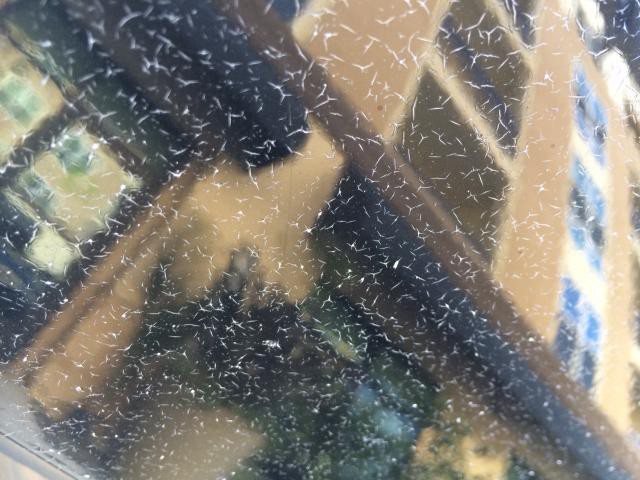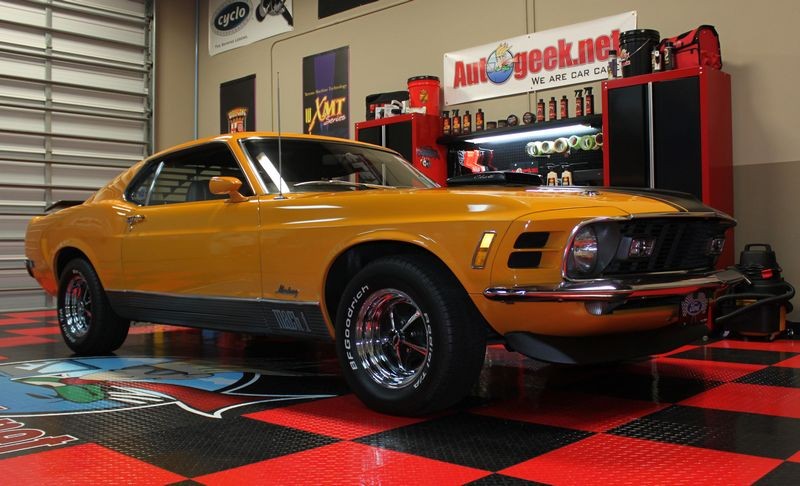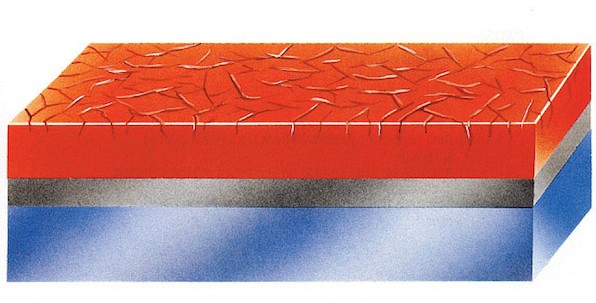Mike Phillips
Active member
- Dec 5, 2022
- 51,004
- 6
Crows Feet - Lacquer Cracking - Paint Checking
Here are pictures of Crows Feet and/or Lacquer Checking
Crows Feet in modern basecoat/clearcoat paint

This is a cropped out section of the original picture above to better show the cracks.

Crows Feet in modern basecoat/clearcoat paint

Crows Feet in modern basecoat/clearcoat paint

Crows Feet in original single stage piant

[/B]1970 Mustang Mach 1 Detailing Clinic at AutogeekOnline.net

Frequently Asked Questions
1: What causes crows feet or lacquer checking?
One cause is the repeated expansion and contraction of the underlying panel. Crows feet and lacquer checking is common on the hoods of cars. One reason for this is due to the heat generated by the engine. The engine heat transfers up to the underneath of the hood and causes the panel to expand. Exposure to sunlight also heats the hood panel and expands the panel and thus the paint. When the hood cools off the panel contracts. To some degree, paint is formulated to be a flexible membrane but there's a limit to how much a layer of paint can expand and contract. Over time and exposure to heat, both engine heat and sunlight heat, paint can become more brittle and less able to flex, when this happens, instead of expanding it cracks.
Old school solvent-evaporation paints like lacquers and enamels are more porous than modern clearcoats and dry out over time which causes them to become more brittle. This is why you can often find lacquer cracking on old single stage paints on other panels besides the hood.
2: Can crows feet or lacquer checking be fixed?
No. The cracks go through or into the paint. Compound, polishing and even wetsanding will remove perfectly good paint surrounding these cracks without removing them.
3: How can crows feet or lacquer checking be fixed?
The only way to fix crows feet or lacquer checking is to repaint the affected area or repaint the panel.
4: How come the crows feet or lacquer checking showed up after polishing?
When you run a polisher over paint that has crows feed or lacquer checking with a compound, polish or AIO, these product lodge or embed into the cracks making them visible.
5: How can I get the compound, polish or wax reside out of the crows feet or lacquer checking cracks?
You can try washing with soap and water. Another option that is risky is to try pressure washing the area, the idea being to blast the residue out of the cracks with pressurized water. The risk with this approach is it's possible to get water UNDER the paint via the cracks and the blast paint off your car. This in essence turns a Mole Hill into a Mountain, as the expression goes.
6: Is there any way to reduce the visibility of the crows feet or lacquer checking?
Some people have had good luck using a colored or pigmented wax.
Paint Checking
The below info and image are from an article on HOTROD Network
Help With Troubleshooting Paint Problems – The Causes And Curses
Paint Checking, sometimes referred to as crow’s feet, are cracks of various lengths and widths that show up in a topcoat (if you’ve ever been to El Mirage or any other dry lake bed, you’ll recognize checking right off the bat).
This is one problem that has a number of possible causes. The most common causes are excessive film thickness, too short of a flash time between coats, force-drying your undercoat (like using the blowgun to dry primer), and sometimes by using too much hardener or catalyst in the primer or paint.
The only way to fix checking is to strip all crazed and cracked paint film and do the whole job over. You can usually save yourself a whole lot of work by preventing the problem by actually reading and following all label instructions, by removing checked surfaces completely before you spray over ’em in the first place, and by making sure your material, both undercoats and topcoats, are thoroughly mixed before spraying.
Paint Checking

My comment....
The image above showing paint checking visually shows you why you cannot fix any of these types of defects, Crows Feet, Lacquer Cracking or Paint Checking by abrading the surface. Abrading the surface simply uncovers MORE of the cracks in the paint. If the cracks are very shallow, then it may be possible to remove or at least improve the appearance of this type of defect by my experience is trying to wet sand or compound paint with this type of defect never removes it and results in thinner paint in the area.
The only true fix is to repaint the area. Your other option would be to learn to live with it.

Here are pictures of Crows Feet and/or Lacquer Checking
Crows Feet in modern basecoat/clearcoat paint

This is a cropped out section of the original picture above to better show the cracks.

Crows Feet in modern basecoat/clearcoat paint

Crows Feet in modern basecoat/clearcoat paint

Crows Feet in original single stage piant

[/B]1970 Mustang Mach 1 Detailing Clinic at AutogeekOnline.net

Frequently Asked Questions
1: What causes crows feet or lacquer checking?
One cause is the repeated expansion and contraction of the underlying panel. Crows feet and lacquer checking is common on the hoods of cars. One reason for this is due to the heat generated by the engine. The engine heat transfers up to the underneath of the hood and causes the panel to expand. Exposure to sunlight also heats the hood panel and expands the panel and thus the paint. When the hood cools off the panel contracts. To some degree, paint is formulated to be a flexible membrane but there's a limit to how much a layer of paint can expand and contract. Over time and exposure to heat, both engine heat and sunlight heat, paint can become more brittle and less able to flex, when this happens, instead of expanding it cracks.
Old school solvent-evaporation paints like lacquers and enamels are more porous than modern clearcoats and dry out over time which causes them to become more brittle. This is why you can often find lacquer cracking on old single stage paints on other panels besides the hood.
2: Can crows feet or lacquer checking be fixed?
No. The cracks go through or into the paint. Compound, polishing and even wetsanding will remove perfectly good paint surrounding these cracks without removing them.
3: How can crows feet or lacquer checking be fixed?
The only way to fix crows feet or lacquer checking is to repaint the affected area or repaint the panel.
4: How come the crows feet or lacquer checking showed up after polishing?
When you run a polisher over paint that has crows feed or lacquer checking with a compound, polish or AIO, these product lodge or embed into the cracks making them visible.
5: How can I get the compound, polish or wax reside out of the crows feet or lacquer checking cracks?
You can try washing with soap and water. Another option that is risky is to try pressure washing the area, the idea being to blast the residue out of the cracks with pressurized water. The risk with this approach is it's possible to get water UNDER the paint via the cracks and the blast paint off your car. This in essence turns a Mole Hill into a Mountain, as the expression goes.
6: Is there any way to reduce the visibility of the crows feet or lacquer checking?
Some people have had good luck using a colored or pigmented wax.
Paint Checking
The below info and image are from an article on HOTROD Network
Help With Troubleshooting Paint Problems – The Causes And Curses
Paint Checking, sometimes referred to as crow’s feet, are cracks of various lengths and widths that show up in a topcoat (if you’ve ever been to El Mirage or any other dry lake bed, you’ll recognize checking right off the bat).
This is one problem that has a number of possible causes. The most common causes are excessive film thickness, too short of a flash time between coats, force-drying your undercoat (like using the blowgun to dry primer), and sometimes by using too much hardener or catalyst in the primer or paint.
The only way to fix checking is to strip all crazed and cracked paint film and do the whole job over. You can usually save yourself a whole lot of work by preventing the problem by actually reading and following all label instructions, by removing checked surfaces completely before you spray over ’em in the first place, and by making sure your material, both undercoats and topcoats, are thoroughly mixed before spraying.
Paint Checking

My comment....
The image above showing paint checking visually shows you why you cannot fix any of these types of defects, Crows Feet, Lacquer Cracking or Paint Checking by abrading the surface. Abrading the surface simply uncovers MORE of the cracks in the paint. If the cracks are very shallow, then it may be possible to remove or at least improve the appearance of this type of defect by my experience is trying to wet sand or compound paint with this type of defect never removes it and results in thinner paint in the area.
The only true fix is to repaint the area. Your other option would be to learn to live with it.
